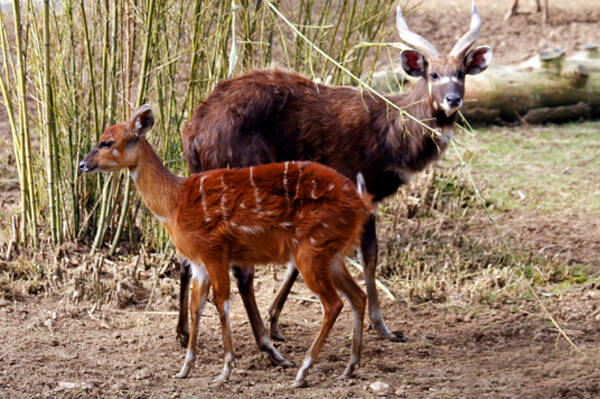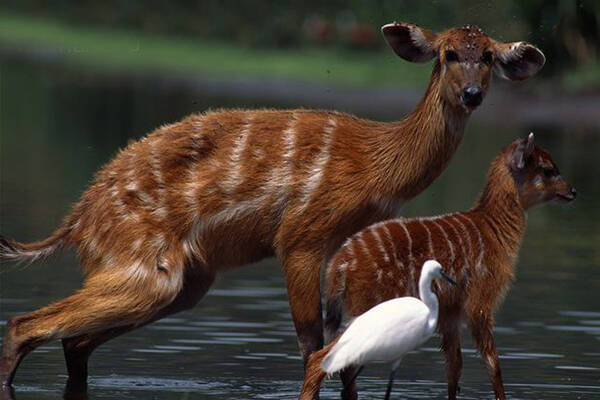Tragelaphus spekii
IUCN
LCBasic Information
Scientific classification
- name:Tragelaphus spekii
- Scientific Name:Tragelaphus spekii
- Outline:Ungulata
- Family:Artiodactyla Bovidae Sapir
Vital signs
- length:115-170cm
- Weight:40-120kg
- lifetime:About 19 years
Feature
Able to stand on dirt and floating vegetation mats without sinking
Distribution and Habitat
Origin: Angola, Benin, Botswana, Burundi, Cameroon, Central African Republic, Chad, Congo, Democratic Republic of Congo, Equatorial Guinea, Gabon, Gambia, Ghana, Guinea, Guinea-Bissau, Kenya, Mozambique, Namibia, Nigeria, Rwanda, Senegal, South Sudan, United Republic of Tanzania, Uganda, Zambia, Zimbabwe.
Possibly extinct: Togo
Regionally extinct: Niger.
Inhabits the swamps of central Africa. Lives in heavily vegetated, muddy swampy areas, usually between swamps and papyrus grass beds.
Appearance
The Sitatla is an aquatic antelope with a body length of 115-170 cm, a shoulder height of 75-125 cm, a tail length of 30-35 cm, and a weight of 40-120 kg. This medium-sized antelope is very dedicated to a semi-aquatic life. In order to adapt to the swampy environment, they have grown four open hooves, which allows the species to stand on mud and floating islands of vegetation without sinking. This unusual animal has elongated cheeks, a slender neck and legs, and the hindquarters are higher than the forequarters, giving it a distinctive curved appearance. The fur is coarse and shaggy, is waterproof, and varies in color. Males are usually gray-brown, while females and sub-adults are usually tan. In addition to the white spots on the body, there are about 6-8 vertical white stripes, and both sexes have distinctive white markings on the cheeks, thighs, throat, and between the eyes. Males are much larger than females, and only males have long spiral horns, up to 45-90 cm long. As they matur
Details
Sitatunga (scientific name: Tragelaphus spekii) is also known as Sitatunga and Marshbuck. It has no subspecies.

Sitatunga is active in the early morning, but sometimes during the day or at night, but is most active at dawn and dusk. Females tend to live in groups, while males spend most of their time solitary after mating. They are good swimmers and divers, often feeding in the water. The animals are strong swimmers, but prefer to rest on dry mounds or floating islands in the marsh, trampling the grass into soft mats. However, when threatened, they will jump and dive into the water to escape predators such as leopards and wild dogs, and almost completely submerge in the water without being noticed by the attacker, with only the nostrils protruding above the waterline.
The marshes provide abundant food at all times of the year, so the bushbucks require only very small home territories, usually using regular passages through tall reeds and papyrus. However, they sometimes leave the marshes at night and forage on the edges of nearby forests to avoid predators. They are herbivorous, and their food consists of leaves from reeds, hedges, and shrubs in the marsh, as well as grass in the adjacent river forests. Fallen fruits and the bark of some trees and shrubs are also eaten.
During mating, the male approaches the female in a low, stretched posture, while the female may slowly retreat. When the male is within a few inches of the female, he may be suddenly carried away, causing considerable commotion in the swamp. The male insists on following, but always lags behind. Mating in this species is characterized by the male placing his head and neck on the female's back and lifting his front legs off the ground in an increasing attempt. The female responds with a neck wrap, in which she tilts her neck downward and thrusts her head sharply upward and back, with her mouth wide open. The male then rests his head on the female's back, while the female's head and neck are tilted forward and down.

The reproduction of the bushbuck can be carried out throughout the year. Males are polygamous, and females give birth to a cub every 11.6 months on average. The average gestation period is 247 days. Females reach sexual maturity at around 1 year old, and males reach sexual maturity at around 1.5 years old.
Newborn antelopes are hidden by their mothers on a grass platform of dry reeds growing in deep water in the swamp. The antelopes cannot walk through the swamp as slowly and calmly as adult antelopes. They follow their mothers for several months before learning how to walk in the swamp. The mother antelope takes the antelope to the hiding place to feed. When leaving, she will walk to the antelope, lick the nose of the antelope, and then walk forward. The antelope stands up and follows the mother antelope. The mother antelope takes it to a safe and hidden place to feed.
Listed in the 2016 Red List of Endangered Species of the World Conservation Union (IUCN) ver3.1-Least Concern (LC).
Protect wild animals and stop eating game.
Maintaining ecological balance is everyone's responsibility!








